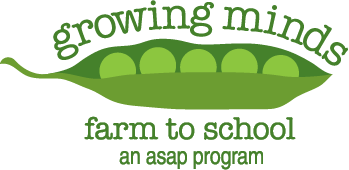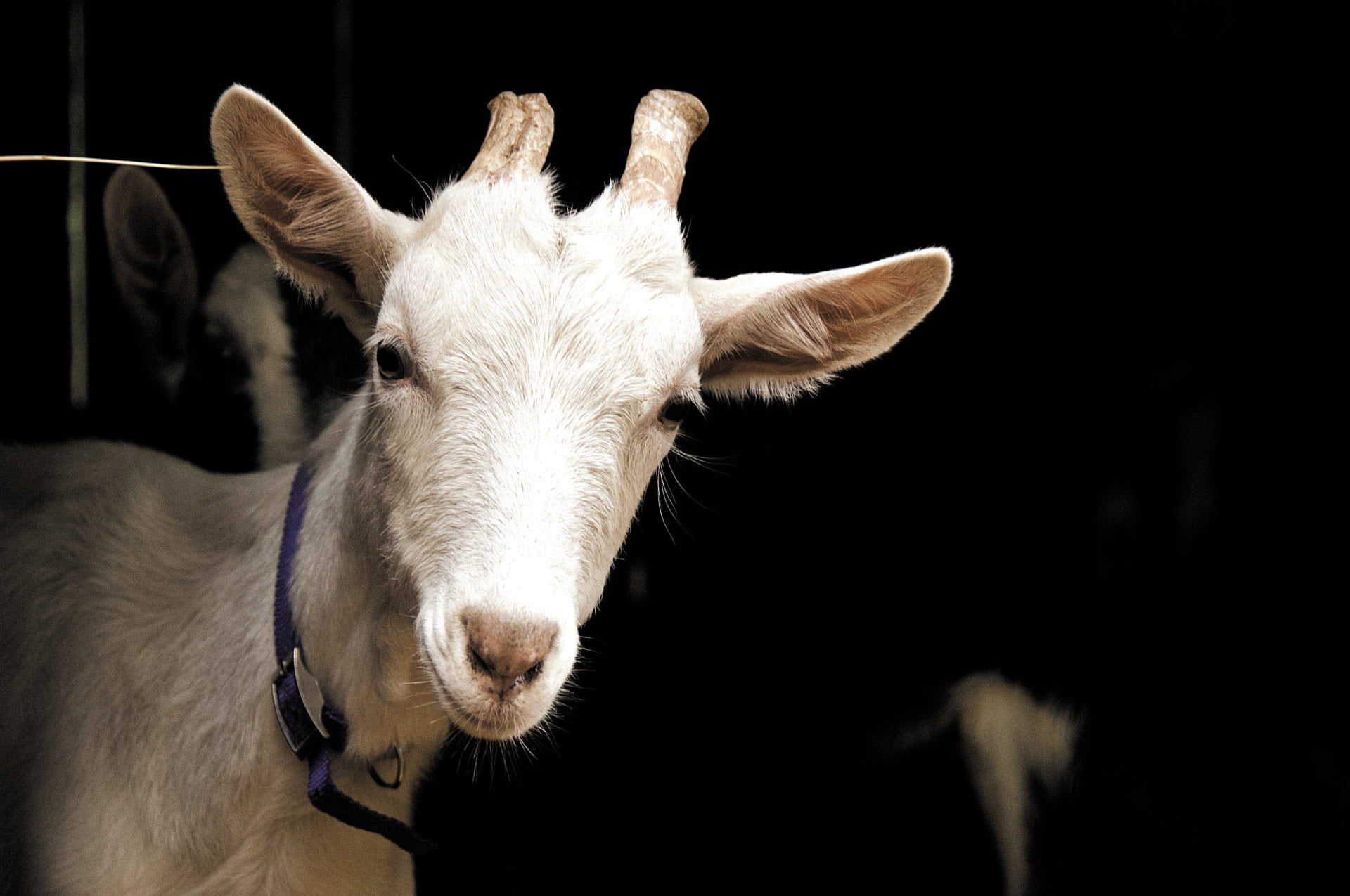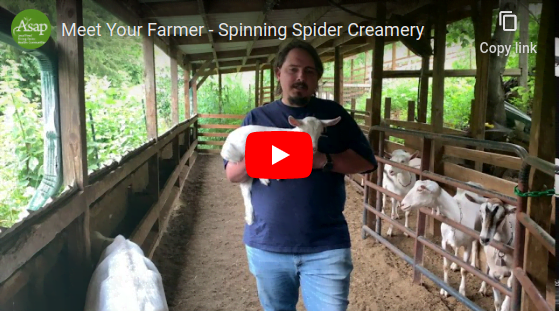This week’s theme is goats. Our “Growing Minds Day by Day” educational resource lists are designed for families and educators.
Goats are some of the livestock that are raised on farms in our region. Depending on the breed, goats may be raised for milk, cheese, butter, meat, fiber, or hides. They can also be used as living “lawn-mowers” for weed management or control, as they don’t mind eating invasive shrubs and vines such as kudzu (you’ll sometimes see them grazing on the sides of highways for this reason–we’ve spotted them munching in the mountains along Interstate 26!). Goats are curious creatures and terrific climbers. Here are some more fun facts about goats:
- Goats are members of the animal family bovidae, along with bison and domesticated cattle. They’re closely related to sheep.
- Goats are ruminants with a four-chambered stomach. They are browsers that will sample many plants in order to find what they like to eat.
- Like people, juvenile goats are called “kids”. Female goats often give birth to twins.
- Goats were first domesticated as livestock between 8,000 and 10,000 years ago in Western Asia.
- Cashmere wool is a fine and soft natural fiber that is harvested from cashmere goats and used to make scarves, sweaters and other textiles.
- There are over 300 distinct breeds of goats!
Family farms in Western North Carolina that raise goats include Spinning Spider Creamery, Three Graces Dairy, and Good Fibrations. Use ASAP’s online Local Food Guide to search for these and more farms in the Appalachian Grown region that raise goats (many of which accept visitors). Use the resources below to learn more about these animals.
Books:
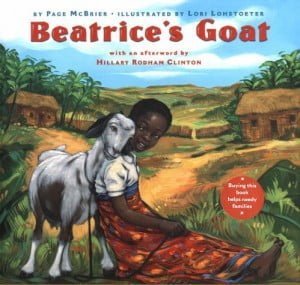 Beatrice’s Goat
Beatrice’s Goat
More than anything, Beatrice longs to be a schoolgirl. But in her small Ugandan village, only children who can afford uniforms and books can go to school. Beatrice knows that with six children to care for, her family is much too poor. But then Beatrice receives a wonderful gift from some people far away–a goat! Fat and sleek as a ripe mango, Mugisa (which means “luck”) gives milk that Beatrice can sell. With Mugisa’s help, it looks as if Beatrice’s dream may come true after all. Page McBrier and Lori Lohstoeter beautifully recount this true story about how one child, given the right tools, is able to lift her family out of poverty. This story is based on the work of Heifer Project International–a charitable organization that donates livestock to poor communities around the world. Watch a read-aloud of this story on YouTube. This book is recommended for ages 4-8.
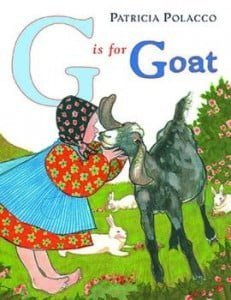 G is for Goat
G is for Goat
Our next recommendation by author/illustrator Patricia Polacco is for the little readers. Letter by letter, meet cart-pulling goats, clothes-munching goats, head-butting, hill-climbing, tail-wagging goats! Cats, chicks, dogs, and bunnies play along with these friendly goats, joining in the fun. From A is for Apple to Z is for Zoe, these rascally animals just won’t stop until they’ve romped through the whole alphabet. Watch a read-aloud on YouTube. This book is recommended for ages 2-5.
Find more books Visit the Growing Minds’ farm to school literature database to discover more of our favorite children’s books about goats and farm animals.
Local Food Recipe:
Garden Plot Crackers
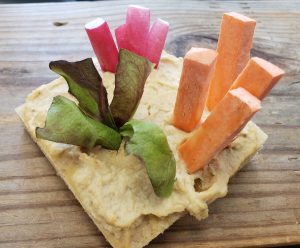 Materials:
Materials:
- A variety of local vegetables
- Large crackers or a piece of bread (one per child)
- Spread for crackers/bread (hummus, cream cheese, or goat cheese)
- Plastic knives
- Knife (for adult use only)
- Cutting board
- Plates, bowls
Preparation:
Wash and cut all vegetables into small pieces. Assemble a bowl for each child that contains each of the cut up vegetables.
Directions:
- Give each child a paper plate with a cracker of a piece of bread on it and a bowl of chopped vegetables.
- Place a container of hummus, cream cheese, or goat cheese, and a plastic knife at every table or in reach of each group of children or make individual bowls of spread for each child.
- Have the children spread the hummus/cream cheese/goat cheese onto their cracker/ bread using their plastic knife.
- Encourage the children to pretend that they are planting a garden. They can use the cut up vegetables to pretend to plant a garden on their cracker/bread.
Would you like to take this activity further? Download our full lesson plan for garden plot crackers, available for preschool or grades K-2.
More recipes
Ready to try something more adventurous? Click here to get the recipes for two Fall-flavored dishes: Autumn Glow Salad with Feta, and Apple, Pecan, and Goat Cheese Pizza.
Educational Resources:
Growing Minds Lesson Plans
- Farm Animals (K-2): Students will be introduced to different farm animals and learn about what food and materials they can provide to us and our community.
- Bacteria for Breakfast Lesson Plan (3-5): Students learn the process of turning milk into yogurt by using different bacteria starts and comparing results.
- Butter Investigation (3-5): Students will predict how much butter will be made from different types of milk and test their hypothesis.
Activities:
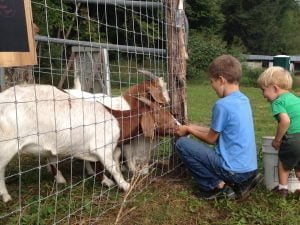 Farm Stories
Farm Stories
Farmers don’t just grow fruits and veggies, they grow animals too. Many farms in our Appalachian region raise pigs, chickens, goats, cattle, and honey bees, and some raise more unusual creatures, like trout, alpacas, or bison. Introduce children to the variety of animals that live on farms. Help them understand the commitment involved in raising farm animals. Make the connection to the responsibilities they may be familiar with that come along with owning a pet.
Encourage your child to come up with a story about a day in the life of a goat. What does the goat eat? Where does it play or sleep? What other people or animals does it interact with throughout the day?
Once they’ve come up with a story, children can illustrate a scene about their goat and the farm it lives on by making a drawing, painting, or a shoebox diorama. They could even create a song or play about their goat and act it out for their class, friends, or family.
Energizer!
Have children play pretend farm animals for this week’s energizer. Explain to children that when you shout out an animal, the child has to walk like that animal would walk. Choose from goats, cows, pigs, turkeys, chickens, sheep, horses, and many more. How do these animals eat, run, and sleep? Have the children attempt to mimic all of these movements (and the sounds the animals make!) in a large open area.
Meet Your (Goat) Farmer:
In our Meet Your Farmer video, meet Chris and Cullen Owen, farmers and cheese makers at Spinning Spider Creamery, an artisan goat dairy in Marshall, North Carolina. Learn about why the Owen’s chose to become farmers, find out what they love most about farming, and learn about the cheese making process. Learn more about Spinning Spider Creamery.
Find more Growing Minds “Meet Your Farmer” videos here.
—
That’s it for this week. Check back next week for new resources. Click here to access Day by Day resources from past weeks. If you didn’t find what you’re looking for here, please visit our Lesson Plans page.
